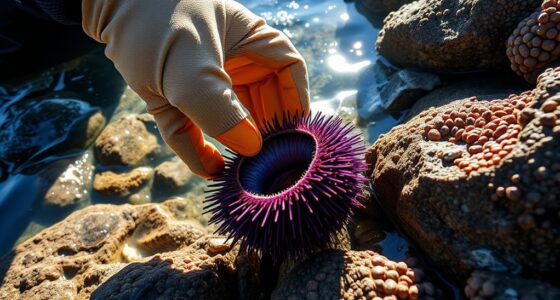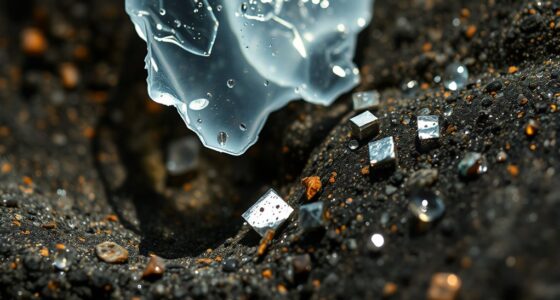To sort and store shellfish at home safely, check that shells are tightly closed or close when tapped, avoiding any that remain open. Smell them for a clean, ocean-like scent without sour or ammonia odors. Keep shellfish cold at 35-40°F in breathable containers like mesh bags or damp cloths, and use them within a day or two. Proper handling and storage prevent spoilage and ensure safety—continue to explore how to best manage shellfish for ideal freshness.
Key Takeaways
- Inspect shells for tight closure or response to tapping; discard open or unresponsive shells.
- Check for foul odors, cracked shells, or signs of spoilage before storing shellfish.
- Keep shellfish cold at 35-40°F using breathable containers like mesh bags or loosely covered bowls.
- Transfer shellfish from plastic bags to a damp cloth to maintain freshness without submersion in water.
- Consume within one to two days and regularly monitor for spoilage signs during storage.

When it comes to enjoying fresh shellfish, knowing how to perform a simple triage at home can save you time and prevent foodborne illnesses. The first step in shellfish triage is evaluating shellfish freshness. Fresh shellfish should smell like the ocean—briny and clean—without any sour or ammonia-like odors. If it smells off or overly fishy, it’s best to discard it. Check the shells: they should be tightly closed or close when tapped. Open shells that don’t close after tapping are a sign the shellfish might be dead and unsafe to eat. For shellfish sold live, like mussels, clams, and oysters, verify they are alive before cooking. Dead shellfish spoil quickly and can harbor harmful bacteria, so err on the side of caution.
Once you’ve confirmed the shellfish’s freshness, proper storage techniques become key to maintaining quality and safety. When storing shellfish at home, keep it cold—ideally at 35-40°F (1-4°C)—until you’re ready to cook. Use a breathable container, such as a mesh bag or a loosely covered bowl, rather than airtight plastic wrap or sealed containers. This allows excess moisture to escape and prevents the shellfish from suffocating, which can cause spoilage. If you’ve purchased shellfish in a plastic bag, transfer it to a container with a damp cloth on top to maintain humidity without trapping excess water. Avoid submerging shellfish in fresh water, as this can kill them and compromise their freshness.
Timing is also vital; plan to cook shellfish within a day or two of purchase. If you need to store it longer, keep it in the coldest part of your fridge and check regularly for any signs of spoilage. When handling shellfish, always wash your hands before and after to prevent cross-contamination. Discard any shellfish with cracked shells, foul odors, or shells that are open and unresponsive after tapping. Proper storage techniques not only preserve shellfish freshness but also reduce the risk of foodborne illnesses caused by bacteria like Vibrio vulnificus.
Frequently Asked Questions
How Long Can Shellfish Be Stored Safely at Home?
You can typically store shellfish safely at home for 1 to 2 days, depending on the type. Shellfish shelf life is shortest for oysters and clams, which should be consumed within a day or two, while mussels may last up to three days if kept properly. To maximize storage duration, keep shellfish cold in the refrigerator at or below 40°F, and always check for freshness before cooking.
Can I Freeze Shellfish After Triage?
Yes, you can freeze shellfish after triage to preserve its freshness. Think of freezing shellfish as putting a pause button on its quality. Use proper storage techniques—wrap them tightly in airtight containers or vacuum-seal bags to prevent freezer burn. Place them in the coldest part of your freezer, and aim to consume within a few months for the best taste and safety. Freezing shellfish is a smart way to extend its shelf life.
What Signs Indicate Shellfish Is Unsafe to Eat?
You’ll know shellfish is unsafe to eat if it smells off, like a strong, ammonia-like odor, or if it feels slimy and sticky. Discolored shellfish or shells that don’t close when tapped are signs of poor shellfish freshness. Avoid eating shellfish with cracked or broken shells, as these are unsafe indicators. Always trust your senses—if something seems unusual, it’s best to discard it for safety.
Are There Eco-Friendly Ways to Dispose of Shellfish Shells?
You can eco-friendly dispose of shellfish shells by composting shells if your compost area allows it, as shells add calcium to the soil. Alternatively, consider recycling shells through local programs or marine debris cleanup initiatives. Avoid dumping shells in regular trash, as they don’t decompose quickly and can harm the environment. Recycling shells helps reduce waste and supports sustainable practices, turning your seafood leftovers into beneficial resources.
How Do I Prevent Shellfish From Spoiling During Storage?
To prevent shellfish from spoiling during storage, you need to keep it cold and dry. Properly chilling shellfish extends its shelf life, slowing seafood spoilage. Avoid leaving shellfish at room temperature, which accelerates spoilage. Use airtight containers or perforated bags in the refrigerator, and consume within a few days. By managing temperature and moisture, you guarantee freshness, maximize shellfish shelf life, and prevent seafood spoilage before it happens.
Conclusion
Now that you’ve mastered the art of DIY shellfish triage, you’ll confidently sort, select, and store with skill and speed. By balancing your brilliance with basic biology, you’ll keep your catch fresh and flavorful. Remember, proper prep prevents problems and prolongs pleasure. So, stay sharp, stay savvy, and savor the seafood success you’ve sorted and stored yourself. With careful care and cleverness, your shellfish will stay splendidly succulent, ready to relish whenever you’re ready.










